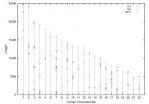The research shows that development assistance for health has grown 375% from $5.66 billion in 1990 to $26.87 billion in 2010. However, IHME's preliminary estimates show that the growth rate is slowing. Between 2004 and 2008, the period of the most dramatic increases in health funding, assistance grew by an annual average of 13%. But between 2008 and 2010, the rate of growth was cut by more than half to 6% annually. Most health funding has gone to the countries with the greatest need, but researchers found striking anomalies, including the fact that 11 of the 30 countries with the highest number of people suffering from disease and high mortality receive less health funding than countries with stronger economies and lower disease burdens.
The report, Financing Global Health 2010: Development assistance and country spending in economic uncertainty, will be released today at the Council on Foreign Relations in New York. It provides a comprehensive picture of the total amount of health funding between 1990 and 2008 from aid agencies and governments in 23 developed countries, multilateral institutions such as the World Health Organization, and hundreds of nonprofit groups and charities. In addition, IHME developed new analytical methods that draw on government budgets, expenditure patterns, and data from funders to make preliminary estimates for 2009 and 2010, overcoming a two-year lag in the reporting of health assistance.
"Everyone in the global health community is worried about how the economic crisis is going to affect giving. We knew we couldn't wait for two years to find out," Dr. Murray said. "Research has shown that economic downturns don't usually have an immediate effect on charitable giving, but we were still surprised to see sustained growth through 2010."
The report documents the continued rise in health funding and the effects of that funding on spending for health by governments in developing countries. The report's findings include: Country governments and private donors are driving the increases in development assistance for health. The US government and private donors in the US made up one-half of all funding in 2008. US-based NGOs have been hit hard by the economic downturn, and the amount of health funding spent by them decreased 24% from 2009 to 2010. Significant improvements in transparency make it easier to track how health funds are being used. In 1990, 65% of all public health funding from donor countries was considered "unspecified," with no information available about the primary recipient of the funds. In 2008, that fraction had dropped to 1%. In the US, more than 30% of all funding was unspecified as recently as 2007. By 2008, though, the US government reported detailed information for 100% of its health assistance. Spending on HIV/AIDS programs has continued to rise at a strong rate, making HIV/AIDS the most funded of all health focus areas. Funding for maternal, newborn, and child health received about half as much funding as HIV/AIDS as of 2008. Malaria and tuberculosis are often included with AIDS as top priorities in combatting infectious diseases, but both receive far less funding than AIDS: $1.19 billion for malaria in 2008 and $0.83 billion for tuberculosis. Funding for malaria and tuberculosis also appears to go to countries that do not have large groups at risk for these diseases. For example, of the 30 countries that receive the most malaria health funding adjusted for disease burden, only three – Eritrea, Sao Tome and Principe, and Swaziland – are located in sub-Saharan Africa, where malaria is most acute. Despite much discussion about the need for general health sector support, funding for that area has grown slowly since 2006. Funding for noncommunicable diseases, another popular topic among global health advocates, represents just 0.5% of all development assistance for health. The commitment to health in the developing world grew dramatically over the past two decades. Governments of developing countries increased spending on health. In countries where governments receive significant donor funding, development assistance for health appears to be partially replacing domestic health spending instead of fully supplementing it. Conversely, in countries that receive health funding mainly through NGOs, government health spending appears to increase.
The researchers suggest that a likely drop-off in future health funding may not yet be apparent because of multiyear commitments made by governments in stronger economic times. They also indicate that the intensified focus on certain health issues – such as maternal, newborn, and child health, noncommunicable diseases, and health sector support – is likely to magnify the competition for limited resources and exacerbate the effects of any downturn in development assistance for health.
"More than 300,000 mothers still die every year, and more than 7 million children die before the age of 5. Chronic diseases need more attention, and countries need better health care infrastructure," Dr. Murray said. "All of these pressing health issues require funding, and it is becoming increasingly difficult to balance competing needs." ###
The Institute for Health Metrics and Evaluation (IHME) is an independent global research center at the University of Washington providing sound measurement of population health and the factors that determine health, as well as rigorous evaluation of health system and health program performance. The Institute's goal is to improve population health by providing the best evidence possible to guide health policy – and by making that evidence easily accessible to decision-makers as they strategically fund, design, and implement programs to improve health outcomes worldwide. IHME was created in 2007 through funding from the Bill & Melinda Gates Foundation and the state of Washington.
For more information, please visit http://www.healthmetricsandevaluation.org
Media contact:
William Heisel
(206) 897-2886; cell: 206-612-0739
wheisel@uw.edu
The report, figures, and tables are accessible at: http://www.healthmetricsandevaluation.org


